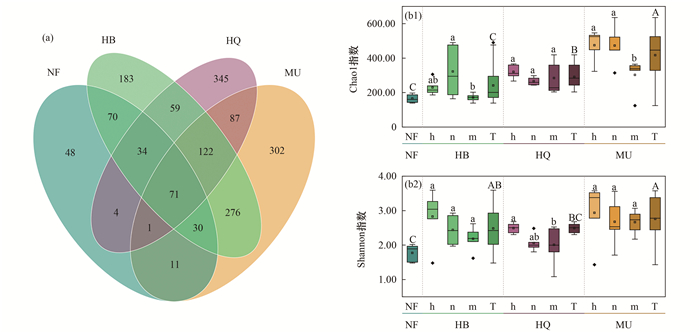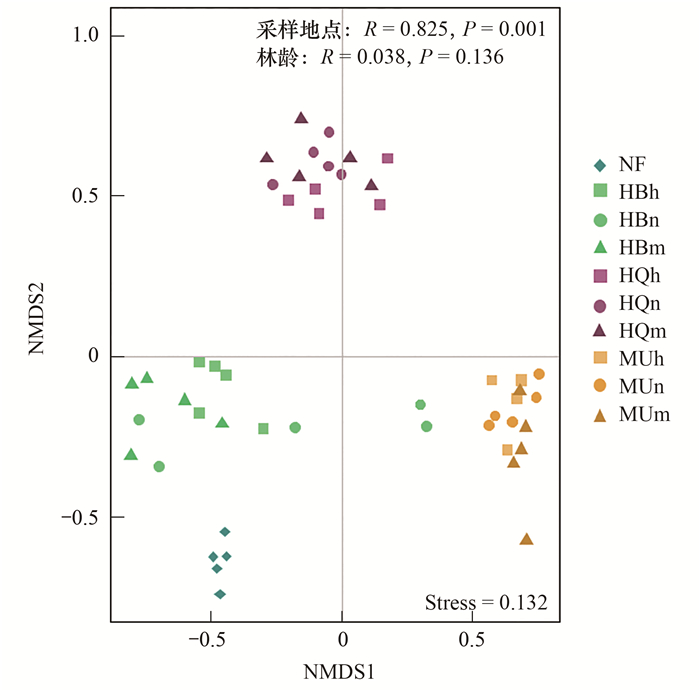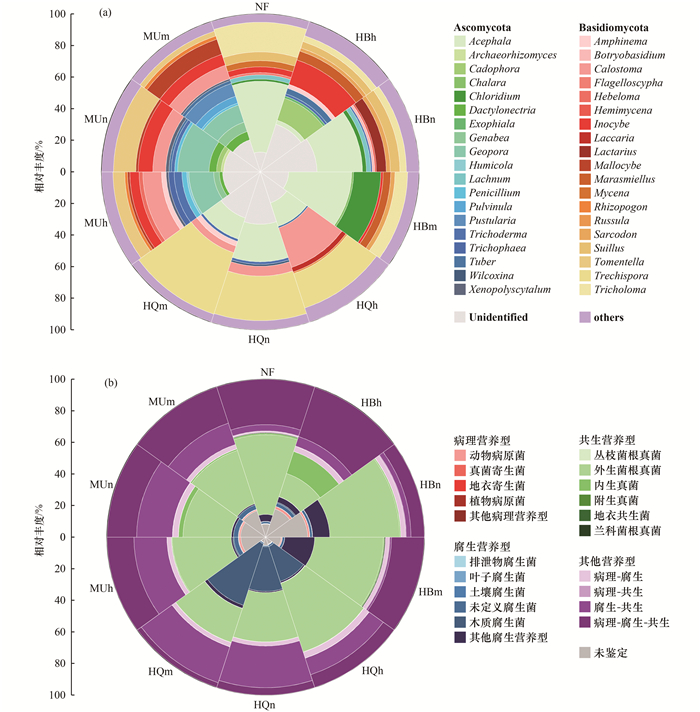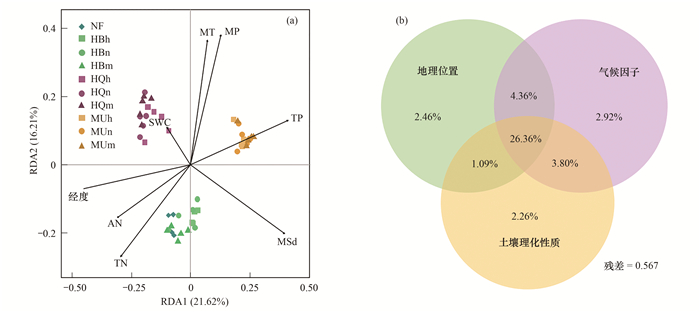2. 宁夏盐池毛乌素沙地生态系统国家定位观测研究站, 盐池 751500;
3. 北京林业大学水土保持国家林业和草原局重点实验室, 北京 100083;
4. 中国水利水电科学研究院, 北京 100038
2. Yanchi Ecology Research Station of the Mu Us Desert, Yanchi 751500, China;
3. Key Laboratory of State Forestry and Grassland Administration on Soil and Water Conservation, Beijing Forestry University, Beijing 100083, China;
4. China Institute of Water Resource and Hydropower Research, Beijing 100038, China
根内真菌(root-associated fungi, RAF)定殖于植物根系, 表现出多种多样的功能特征, 被视为植物寄主的第二个基因组[1].其中, 腐生真菌作为分解者能够分解植物残体, 参与土壤养分的分解和转化; 病原菌侵染寄主植物, 可导致植物病害发生; 共生真菌则主要包括菌根真菌和内生真菌两种类型, 能够协助寄主植物抵抗病菌侵害.一方面, 菌根真菌能够促进寄主植物吸收水分和养分, 提高寄主植物水分和养分利用效率; 另一方面, 内生真菌则可通过调节植物激素和次生代谢产物协助寄主植物应对环境胁迫, 对植物生长起到积极作用[2].因此, 在森林生态系统中, 根内真菌功能群组成直接影响林木生长和健康状态, 体现了森林生态系统稳定性的微生物视角[3].
根内真菌群落结构和功能群组成主要受到寄主植物自身特性和环境因子的影响.寄主植物特异性或偏好决定了根内真菌群落[4], 但对单一寄主而言, 林龄是影响根内真菌群落的重要因素[5~7], 塑造了根内真菌群落结构和功能的时间动态模式.不仅如此, 生境过滤作用能将生态位相似的真菌聚集, 并影响真菌群落构建[8].在大空间尺度上, 由海拔和经纬度等地理位置因素造成的气候条件差异比其他因素更能解释根内真菌群落结构和功能的变化[9]; 在小空间尺度上, 土壤理化性质对根内真菌群落具有较强的塑造作用[10, 11].因此, 研究揭示根内真菌群落结构和功能群组成时空动态特征有利于深入了解寄主和根内真菌群落之间复杂的相互作用.
我国北方地区土地沙化严重, 严重影响了区域生态、社会和经济的可持续发展.长期以来, 植被恢复是防沙治沙, 改善区域生态环境的有效途径[12].樟子松(Pinus sylvestris var. mongolica)具有较强的适应性和抗逆性, 是我国北方荒漠化地区防风固沙的重要树种, 并被广泛引种栽植[13].樟子松生长生理特征是评价林分生长和生态效益的重要指标[14], 但根内真菌与林木生长和健康状况的相互关系越来越受到国内外学者的关注[15].现阶段, 不同引种区樟子松人工林根内真菌群落组成已有广泛报道[16~18], 但依然缺少对于樟子松根内真菌地理分布和生态功能的全面了解.
鉴于此, 本文以樟子松天然林和不同引种地人工林为研究对象, 通过高通量测序和真菌功能群分析, 旨在:①研究揭示樟子松根内真菌群落结构和功能群组成时空动态特征及其主要影响因素; ②阐明樟子松根内真菌生态功能及其与林木生长和健康状态之间的关系.本研究结果有助于系统识别樟子松根内真菌群落结构和功能群组成在不同时空尺度下组装模式的动态特征, 深入理解根内真菌与樟子松的相互关系, 以期为樟子松人工林可持续经营管理提供理论依据和科技支撑.
1 材料与方法 1.1 研究区概况樟子松天然林样地设置在内蒙古红花尔基樟子松国家森林公园(N48°44′, E120°01′), 引种地人工林样地分别设置在内蒙古海拉尔国家森林公园(N49°12′, E119°36′~39′)、辽宁章古台沙地国家森林公园(N42°42′, E122°29′)和陕西榆林红石峡沙地植物园(N39°19′, E109°42′).其中, 红花尔基樟子松国家森林公园和海拉尔国家森林公园位于呼伦贝尔沙地东南部, 属于中温带半湿润大陆性季风气候区; 章古台沙地国家森林公园位于科尔沁沙地南缘, 属于温带亚湿润大陆性季风气候区; 红石峡沙地植物园位于毛乌素沙地东南部, 属暖温带大陆性季风气候区.研究区气候条件和主要植被详见表 1.
|
|
表 1 研究区樟子松林地概况1) Table 1 Location and climate information of the Pinus sylvestris var. mongolica forests |
1.2 样本采集与处理
分别选取呼伦贝尔沙地(HB)、科尔沁沙地(HQ)和毛乌素沙地(MU)不同林龄樟子松人工林:23~24 a(半熟林, h)、33~36 a(近熟林, n)和44~45 a(成熟林, m), 并以呼伦贝尔沙地樟子松天然林(NF)为对照(表 1).总共设置10个样地, 包括1个天然林样地和9个人工林样地(3个沙地×3个林龄), 每个样地包含5个20 m×20 m的样方.
2019年7月, 展开野外调查采集樟子松根尖及对应的土壤样品.在每个样方中随机选择间距10 m以上的3棵标准木作为采样对象, 去除地表覆盖物, 采集樟子松根末级的根尖样品.将同一样方的3棵标准木根尖样品充分混合, 则每个样地有5个重复, 10个样地共计采集了50个根尖样品.采样完成后立即将样品置于-4℃便携式保温箱保存, 带回后存放于-80℃冰箱备用.同时, 采用相同采样方法采集根系附近土壤样品用于后期的土壤理化性质分析.
1.3 根内真菌分子鉴定和功能群划分使用PowerSoilⓇ DNA Kit(MoBio Laboratories, Carlsbad, CA)试剂盒对根内真菌DNA抽提, 并用真菌通用引物ITS1F(5′-CTTGGTCATAGACGAAGT AA-3′)和ITS2(5′-GCTGCGTTCTTCAGATGC-3′)对rDNA ITS区进行PCR扩增.对PCR扩增产物进行凝胶电泳检测, 利用Illumina MiSeq制备测序文库.在剔除低质量序列后, 以97%为阈值对有效序列划分OTU.为减小因数据量不同而造成的误差, 所有样本序列数抽平为18 191条序列.
基于FUNGuild平台划分真菌功能群[19], 对置信度为“很可能”(probable)和“极可能”(highly probable)的划分结果进行保留.同时, 将置信度为“可能”(possible)的划分结果与先前研究进行对比, 以确定其功能类型.将具有复合营养型(trophic mode)或复合功能群(guild)的群落分别归纳为“其他营养型”和“其他病理(或腐生, 或共生)营养型”.
1.4 气象数据来源和土壤理化性质测定气象数据来源于中国气象科学数据中心(http://data.cma.cn), 时间范围为2009~2018年, 用以计算年平均日照时数(MSd)、年平均气温(MT)和年平均降水量(MP), 见表 1.
采用环刀烘干称重法测定土壤含水量(SWC), 采用pH分析仪(上海雷磁, 中国)测定土壤pH值(pH), 采用重铬酸钾稀释热法测定土壤有机碳(SOC)含量, 采用靛酚蓝比色法测定全氮(TN)含量, 采用钼锑抗比色法测定全磷(TP)含量, 采用碱解扩散法测定有效氮(AN), 采用碳酸氢钠法测定有效磷(AP).研究区土壤理化性质详见表 2.
|
|
表 2 研究区樟子松林地土壤理化性质特征1) Table 2 Soil properties of the Pinus sylvestris var. mongolica forests |
1.5 数据分析
根据相对丰度≥10.00%的真菌属划分为优势属, 1.00% ~10.00%为常见属, < 1.00%为稀有属[20].运用R studio进行数据处理和绘图, 包括韦恩图、多样性指数计算(Chao1和Shannon)、非度量多维尺度(NMDS)及相似性分析(ANOSIM)、指示菌种鉴定(Indicator species analysis)、斯皮尔曼相关性检验(Spearman's rank correlation)、冗余分析(RDA)和方差分解分析(VPA).采用SPSS 20进行差异性分析, 包括单因素方差分析(one-way ANOVA)和双因素方差分析(two-way ANOVA).采用OriginPro 2018绘制多样性图和群落组成玫瑰图.
2 结果与分析 2.1 樟子松根内真菌群落多样性樟子松天然林和人工林根尖样品共有2 246 585条优质序列, 在抽平并剔除非真菌OTU后, 共获得可划分OTU数量1 643个.根内真菌OTU数量大小为:天然林<科尔沁沙地人工林 < 呼伦贝尔沙地人工林 < 毛乌素沙地人工林[图 1(a)].其中, 天然林共有OTU 269个, 约占总数的16.37%; 而毛乌素沙地人工林OTU数量高达900个, 约占总数的54.78%.樟子松天然林、呼伦贝尔沙地、科尔沁沙地和毛乌素沙地人工林特有OTU分别为48、183、345和302个; 天然林和人工林共有OTU 11个, 人工林共有OTU 122个.

|
(a) 樟子松天然林和人工林根内真菌OTU分布Venn图, (b) 樟子松天然林和人工林根内真菌α多样性指数; T: 同一沙地人工林的总和; 不同大写字母表示不同引种地差异显著性(P < 0.05), 不同小写字母表示同一采样地点人工林不同林龄间差异显著性(P < 0.05) 图 1 樟子松天然林和人工林根内真菌OTU比较及多样性指数 Fig. 1 Comparison of root-associated fungal OTU and diversity in Pinus sylvestris var. mongolica natural forests and plantations |
从空间尺度看, 樟子松天然林根内真菌群落多样性指数最小, 毛乌素沙地人工林多样性指数最大[图 1(b)]; 樟子松人工林根内真菌群落存在聚集性特征, 且存在显著差异(P < 0.05, 图 2).从时间尺度看, 呼伦贝尔沙地和毛乌素沙地成熟林中Chao1指数显著低于其他两个林龄(P < 0.05); Shannon指数则随林龄增加不断减少, 但林龄间差异不显著[P>0.05, 图 1(b)]; 林龄对根内真菌群落组成无显著影响(P>0.05, 图 2).

|
图 2 樟子松天然林和人工林根内真菌群落的非度量多维尺度排序及相似性分析 Fig. 2 NMDS and ANOSIM of root-associated fungal community composition in Pinus sylvestris var. mongolica natural forests and plantations |
樟子松天然林、人工林根内真菌隶属于10门30纲89目194科354属.其中, 子囊菌门(Ascomycota)和担子菌门(Basidiomycota)占绝对优势, 其在所有样地中的平均相对丰度分别为51.94%和46.99%[图 3(a)].樟子松天然林、呼伦贝尔沙地、科尔沁沙地和毛乌素沙地人工林优势属和常见属分别为8、8~11、5~6和12~15个.樟子松天然林和人工林根内真菌功能群组成存在明显差异[图 3(b)], 天然林共生营养型真菌数量较多(51.71%), 尤其是外生菌根真菌(50.49%), 主要包括Acephala、小菇属(Mycena)和乳牛肝菌属(Suillus); 科尔沁沙地人工林中腐生营养型真菌较多, 相对丰度为32.92%, 以木质腐生真菌为主(30.81%); 病理营养型真菌分布则较为均匀.

|
(a) 樟子松天然林和人工林根内真菌的优势属和常见属, (b) 樟子松天然林和人工林根内真菌的功能群组成 图 3 樟子松天然林和人工林根内真菌群落分布和相对丰度 Fig. 3 Distribution and relative abundances of root-associated fungal community Pinus sylvestris var. mongolica natural forests and plantations |
樟子松天然林、呼伦贝尔沙地和科尔沁沙地人工林指示菌种分别为5、6和5个, 而毛乌素沙地人工林中则为15个, 其中具有共生功能菌种22个(表 3).外生菌根真菌Acephala是天然林相对丰度最高优势属(44.80%), 同时也是呼伦贝尔沙地和科尔沁沙地人工林优势属; 外生菌根真菌肉齿菌属(Sarcodon)是呼伦贝尔沙地人工林的指示菌种, 且仅在该样地为常见属; 外生菌根真菌红菇属(Russula)和美口菌属(Calostoma)是科尔沁沙地人工林指示菌种; 外生菌根真菌地孔菌属(Geopora)、复合营养型真菌Mallocybe和棉革菌属(Tomentella)是毛乌素沙地人工林指示菌种, 且仅在该样地相对丰度大于1.00%.
|
|
表 3 樟子松天然林和人工林根内真菌指示菌种及其功能类型1) Table 3 Indicator genera of root-associated fungi in Pinus sylvestris var. mongolica natural forests and plantations |
2.3 樟子松根内真菌群落与地理位置和环境因子之间的相关性
指示菌种主要受到土壤有效氮、有效磷和林龄的影响, 而土壤含水量、pH值和全氮含量的影响较小(图 4).其中, 有效氮与腐生真菌Chloridium、腐生-共生真菌Pustularia和病理-腐生-共生真菌Dactylonectria呈显著正相关(P < 0.05), 与未鉴定营养型真菌腐质霉属(Humicola)和病理-腐生-共生真菌口蘑属(Tricholoma)呈显著负相关(P < 0.05); 有效磷与Chloridium和美口菌属呈显著正相关(P < 0.05), 与内生真菌背芽突霉属(Cadophora)、腐生-共生真菌威氏盘菌属(Wilcoxina)、腐质霉属和口蘑属呈显著负相关(P < 0.05).林龄与Chloridium和Pustularia呈显著正相关(P < 0.05), 与背芽突霉属、美口菌属、腐质霉属、病理/未鉴定营养型真菌青霉属(Penicillium)和口蘑属呈显著负相关(P < 0.05).

|
1. Flagelloscypha, 2. Mycena, 3. Tricholoma, 4. Lachnum, 5. Acephala, 6. Sarcodon, 7. Exophiala, 8. Chloridium, 9. Marasmiellus, 10. Cadophora, 11. Botryobasidium, 12. Trechispora, 13. Laccaria, 14. Wilcoxina, 15. Russula, 16. Calostoma, 17. Geopora, 18. Pustularia, 19. Mallocybe, 20. Genabea, 21. Rhizopogon, 22. Tomentella, 23. Pulvinula, 24. Humicola, 25. Dactylonectria, 26. Hebeloma, 27. Xenopolyscytalum, 28. Penicillium, 29. Trichophaea, 30. Archaeorhizomyces, 31. Trichoderma; Age: 林龄; *表示0.01 < P ≤0.05, **表示0.001 < P≤0.01, ***表示P ≤0.001 图 4 樟子松天然林和人工林指示菌种与土壤理化性质和林龄之间的相关性 Fig. 4 Correlation between indicator genera and soil properties and stand age in Pinus sylvestris var. mongolica natural forests and plantations |
不同引种地樟子松根内真菌群落主要影响因子存在差异[图 5(a)], 地理位置和环境因子(气候因子和土壤理化性质) 的总解释量为43.25%[图 5(b)].其中, 呼伦贝尔沙地天然林和人工林根内真菌群落主要与年平均气温和降水量有关, 日照时数和土壤含水量是影响科尔沁沙地人工林根内真菌群落的关键因子, 土壤养分对毛乌素沙地人工林根内真菌群落影响较强.

|
(a) 根内真菌群落与地理位置和环境因子的冗余分析, 基于方差膨胀因子(VIF)和前向选择剔除部分变量, (b)地理位置(经度和纬度)、气候因子(MSd、MT和MP)和土壤理化性质(SWC、pH、SOC、TN、TP、AN和AP)对根内真菌群落变化的方差分解分析 图 5 地理位置和环境因子对樟子松天然林和人工林根内真菌群落变化的解释率 Fig. 5 Correlation between root-associated fungi and geographic location and environmental factors in Pinus sylvestris var. mongolica natural forests and plantations |
樟子松根内真菌多样性和群落组成存在明显的空间分布差异性, 其生物地理分布特征与气候条件[21]和寄主特征密切相关[22].科尔沁沙地和毛乌素沙地年平均气温和降水量显著高于呼伦贝尔沙地.一般认为, 土壤真菌群落在降水量高的情况下具有较高多样性[23], 而土壤温度则是真菌生长的重要限制因素[24].虽然导致土壤真菌群落地理分布差异的关键因素是气候条件, 但也与樟子松天然林和人工林的不同生长状况和生物学特性密不可分.一方面, 相对较高的土壤微生物多样性对林木生长具有积极作用[25, 26]; 同时, 天然林林分长势良好, 且复杂的林龄组成和丰富的林下植被使其抗干扰能力强于人工林[27], 但樟子松天然林根内真菌多样性却低于人工林.这进一步证实了在具有多功能性的荒漠生态系统中, 特定微生物类群的多样性比总体丰富度有更强的表征能力[28].另一方面, 引种地与种源地水热条件的较大差异导致樟子松自身生长规律发生变化, 造成人工林早熟或异常发育[29].植物通过招募有益的或特定的群落, 协助自身应对病害发生、改变营养状况以及适应不断变化的环境条件[30].此时, 天然林和人工林樟子松生长发育条件、长势状况对根内真菌群落的塑造作用不可忽略.
林龄是影响樟子松人工林根内真菌群落的一个重要因素, 虽然根内真菌多样性在不同林龄间无显著差异, 但优势属和常见属相对丰度存在波动, 且指示菌种与林龄相关性较强.首先, 人工林单一的植物类型导致林内缺乏多样的植被-真菌共生关系, 因此不同沙地的樟子松人工林根内真菌多样性随林龄增长均无明显波动[31].其次, 根内真菌群落存在一定的时间异质性是因为在植物的生长发育过程中根系的生长状况、根系分泌物的类型和植物残留物的数量不断变化[32, 33], 同时土壤理化性质也随之改变.土壤pH对干旱区土壤真菌群落的影响普遍存在[34], 但由于土壤真菌对pH变化的敏感度较低[35]且研究区土壤pH波动微小, 导致它与樟子松根内真菌群落无显著相关性.此外, 生态系统的养分循环离不开土壤真菌的参与, 土壤养分对真菌群落有着塑造作用[36].毛乌素沙地土壤有机碳、全氮、有效氮和有效磷含量均显著低于其他地区, 因此毛乌素沙地樟子松根内真菌对这些土壤养分更为敏感, 且多为正相关关系.
3.2 樟子松根内真菌的生态功能特征外生菌根真菌在植物-土壤系统中起到积极作用[37], 作为樟子松根内真菌中的优势功能群, 主要包括地孔菌属、丝盖伞属(Inocybe)、乳牛肝菌属、假基块菌属(Genabea)、块菌属(Tuber)、须腹菌属(Rhizopogon)和红菇属等, 这些菌种均为樟子松林中常见外生菌根真菌[38, 39].其中, 乳牛肝菌属是呼伦贝尔沙地樟子松天然林和人工林的优势属, 它已被证实是欧洲赤松(Pinus sylvestris)[40]和樟子松天然林[41]中的常见真菌属.乳牛肝菌属对松科植物具有专一性, 能将土壤中难以利用磷转化为可用形式[42].指示菌种红菇属(科尔沁沙地人工林)、须腹菌属和假基块菌(毛乌素沙地人工林)都能广泛定殖于针叶植物, 并提高植物的抗逆性[43~45].丝盖伞属在呼伦贝尔沙地和毛乌素沙地中均为樟子松根内真菌的优势属, 它在多种类型气候区都有所分布, 并能与不同的寄主形成不同类型的共生体[46]. Acephala在樟子松根系中均有分布(尤其是天然林), 这在欧洲赤松和其他针叶人工林中得以证实[47].除此之外, 背芽突霉属, 口蘑属等内生真菌的定殖同样有助于樟子松的生长发育, 它们均被证实能产生多种抗生素来抑制土传病原菌的侵染[48, 49].总的来说, 樟子松天然林比人工林更高的共生营养型真菌占比可能是天然林长势良好的微生物因素.
根内真菌的功能群组成很大程度上决定了植物生长健康与否[50].当病理和腐生营养型真菌占比高于共生营养型时, 植物更易遭受病害[51, 52], 这进一步证实了天然林中的真菌群落结构更有利于樟子松的生长.随着人工林林龄增长, 不同引种地共生营养型与病理和腐生营养型的比例呈现不同的变化趋势, 共生营养型真菌在呼伦贝尔沙地近熟林和成熟林中激增, 在科尔沁沙地逐渐降低, 在毛乌素沙地保持平稳.不同营养型真菌之间的相互作用导致了真菌组成的动态变化.首先, 共生真菌对病原菌的拮抗作用; 其次, 菌根植物对土壤氮利用具有较强的竞争力, 当氮的有效性降低后会抑制腐生真菌和其他微生物分解者[53]; 最后, 樟子松生长过程中对养分的大量需求导致其需要招募更多的外生菌根真菌来提供养分(尤其是氮).
环境因素和植物自身条件是一个不断变化的过程, 这导致了部分真菌表现出多种营养方式.口蘑属、蜡蘑属(Laccaria)、威氏盘菌属、Mallocybe和棉革菌属等这些外生菌根真菌在我国北方樟子松林中普遍存在[54, 55], 它们虽然具有一定的腐生能力, 但它们的分解能力要比腐生真菌弱很多[56].产生真菌营养方式转换的原因是因为随着植物根系的发育、衰老和死亡以及周围生境条件的改变, 根内真菌需要通过调节生态策略来维持自身生理活动[57].
4 结论(1) 樟子松根内真菌群落组成存在明显时空动态特征.樟子松人工林根内真菌多样性指数均显著高于天然林, 但天然林中有更多外生菌根真菌(50.49%).林龄对塑造根内真菌群落时间动态变化的贡献较小, 地理位置、气候因子和土壤理化性质对根内真菌群落组成的解释率为43.25%.樟子松天然林和人工林指示菌种主要受到有效氮、有效磷和林龄的影响.
(2) 不同功能类型根内真菌对樟子松林木生长和健康状况具有重要影响.天然林和人工林根内真菌主要功能群均为外生菌根真菌, 但天然林外生菌根真菌较人工林更丰富, 这为解释天然林的良好长势提供了土壤微生物视角的重要证据.在不同引种地, 樟子松人工林共生、腐生和病理营养型真菌比例随林龄增加表现出不同的变化趋势, 腐生和病理营养型真菌增加可能是樟子松人工林长势衰弱和病虫害发生的重要原因.
| [1] | Lin M, Xiong H, Xiang X C, et al. The effect of plant geographical location and developmental stage on root-associated microbiomes of Gymnadenia conopsea[J]. Frontiers in Microbiology, 2020, 11. DOI:10.3389/fmicb.2020.01257 |
| [2] | Frąc M, Hannula S E, Bełka M, et al. Fungal biodiversity and their role in soil health[J]. Frontiers in Microbiology, 2018, 9. DOI:10.3389/fmicb.2018.00707 |
| [3] | Bardgett R D, van der Putten W H. Belowground biodiversity and ecosystem functioning[J]. Nature, 2014, 515(7528): 505-511. DOI:10.1038/nature13855 |
| [4] | Otsing E, Anslan S, Ambrosio E, et al. Tree species richness and neighborhood effects on ectomycorrhizal fungal richness and community structure in boreal forest[J]. Frontiers in Microbiology, 2021, 12. DOI:10.3389/fmicb.2021.567961 |
| [5] | Birch J D, Lutz J A, Turner B L, et al. Divergent, age-associated fungal communities of Pinus flexilis and Pinus longaeva[J]. Forest Ecology and Management, 2021, 494. DOI:10.1016/j.foreco.2021.119277 |
| [6] | Kolaříková Z, Kohout P, Krüger C, et al. Root-associated fungal communities along a primary succession on a mine spoil: distinct ecological guilds assemble differently[J]. Soil Biology and Biochemistry, 2017, 113: 143-152. DOI:10.1016/j.soilbio.2017.06.004 |
| [7] | Unuk T, Martinovič T, Finžgar D, et al. Root-associated fungal communities from two phenologically contrasting silver fir (Abies alba mill.) groups of trees[J]. Frontiers in Plant Science, 2019, 10. DOI:10.3389/fpls.2019.00214 |
| [8] |
赵鹏宇, 李毳, 柴宝峰. 生境过滤驱动庞泉沟华北落叶松林土壤真菌群落的构建过程[J]. 环境科学, 2018, 39(8): 3876-3884. Zhao P Y, Li C, Chai B F. Environmental filters drive the assembly of the soil fungal community in the Larix principis-rupprechtii forests of the Guandi Mountains[J]. Environmental Science, 2018, 39(8): 3876-3884. DOI:10.13227/j.hjkx.201712148 |
| [9] | Botnen S S, Davey M L, Aas A B, et al. Biogeography of plant root-associated fungal communities in the North Atlantic region mirrors climatic variability[J]. Journal of Biogeography, 2019, 46(7): 1532-1546. |
| [10] | Li S, Shakoor A, Wubet T, et al. Fine-scale variations of fungal community in a heterogeneous grassland in Inner Mongolia: effects of the plant community and edaphic parameters[J]. Soil Biology and Biochemistry, 2018, 122: 104-110. DOI:10.1016/j.soilbio.2018.04.007 |
| [11] |
贾彤, 郭婷艳, 王瑞宏, 等. 铜尾矿白羊草重金属含量对叶际和根际真菌群落的影响[J]. 环境科学, 2020, 41(11): 5193-5200. Jia T, Guo T Y, Wang R H, et al. Effects of heavy metal contents on phyllosphere and rhizosphere fungal communities for Bothriochloa ischaemum in copper tailings area[J]. Environmental Science, 2020, 41(11): 5193-5200. DOI:10.13227/j.hjkx.202004239 |
| [12] | Zhang Y, Cao H Y, Zhao P S, et al. Vegetation restoration alters fungal community composition and functional groups in a desert ecosystem[J]. Frontiers in Environmental Science, 2021, 9. DOI:10.3389/fenvs.2021.589068 |
| [13] | Cao H Y, Gao G L, Zhang Y, et al. Soil bacterial approach to assessing afforestation in the desertfied Northern China[J]. Journal of Cleaner Production, 2021, 292. DOI:10.1016/j.jclepro.2021.125935 |
| [14] | Deng J F, Yao J Q, Zheng X, et al. Transpiration and canopy stomatal conductance dynamics of Mongolian pine plantations in semiarid deserts, Northern China[J]. Agricultural Water Management, 2021, 249. DOI:10.1016/j.agwat.2021.106806 |
| [15] | Singh B K, Liu H W, Trivedi P. Eco-holobiont: a new concept to identify drivers of host-associated microorganisms[J]. Environmental Microbiology, 2020, 22(2): 564-567. DOI:10.1111/1462-2920.14900 |
| [16] |
魏晓帅, 郭米山, 高广磊, 等. 呼伦贝尔沙地樟子松根内真菌群落结构与功能群特征[J]. 北京大学学报(自然科学版), 2020, 56(4): 710-720. Wei X S, Guo M S, Gao G L, et al. Community structure and functional groups of fungi in the roots associated with Pinus sylvestris var. mongolica in the Hulunbuir Sandy Land[J]. Acta Scientiarum Naturalium Universitatis Pekinensis, 2020, 56(4): 710-720. DOI:10.13209/j.0479-8023.2020.040 |
| [17] |
赵珮杉, 郭米山, 高广磊, 等. 科尔沁沙地樟子松根内真菌群落结构和功能群特征[J]. 林业科学, 2020, 56(9): 87-96. Zhao P S, Guo M S, Gao G L, et al. Characteristics of community structure and functional group of fungi in roots of Pinus sylvestris var. mongolica in the Horqin Sandy Land[J]. Scientia Silvae Sinicae, 2020, 56(9): 87-96. |
| [18] | Zhao P S, Guo M S, Gao G L, et al. Community structure and functional group of root-associated Fungi of Pinus sylvestris var. mongolica across stand ages in the Mu Us Desert[J]. Ecology and Evolution, 2020, 10(6): 3032-3042. DOI:10.1002/ece3.6119 |
| [19] | Nguyen N H, Song Z W, Bates S T, et al. FUNGuild: an open annotation tool for parsing fungal community datasets by ecological guild[J]. Fungal Ecology, 2016, 20: 241-248. DOI:10.1016/j.funeco.2015.06.006 |
| [20] | Zhao P S, Gao G L, Ren Y, et al. Intra-annual variation of root-associated fungi of Pinus sylvestris var. mongolica: the role of climate and implications for host phenology[J]. Applied Soil Ecology, 2022, 176. DOI:10.1016/j.apsoil.2022.104480 |
| [21] | Jiao S, Zhang B G, Zhang G Z, et al. Stochastic community assembly decreases soil fungal richness in arid ecosystems[J]. Molecular Ecology, 2021, 30(17): 4338-4348. DOI:10.1111/mec.16047 |
| [22] | Rudgers J A, Fox S, Porras-Alfaro A, et al. Biogeography of root-associated fungi in foundation grasses of North American plains[J]. Journal of Biogeography, 2022, 49(1): 22-37. DOI:10.1111/jbi.14260 |
| [23] | Tedersoo L, Bahram M, Põlme S, et al. Global diversity and geography of soil fungi[J]. Science, 2014, 346(6213). DOI:10.1126/science.1256688 |
| [24] | Timling I, Dahlberg A, Walker D A, et al. Distribution and drivers of ectomycorrhizal fungal communities across the North American Arctic[J]. Ecosphere, 2012, 3(11). DOI:10.1890/ES12-00217.1 |
| [25] | Jiao S, Chen W M, Wang J L, et al. Soil microbiomes with distinct assemblies through vertical soil profiles drive the cycling of multiple nutrients in reforested ecosystems[J]. Microbiome, 2018, 6(1). DOI:10.1186/s40168-018-0526-0 |
| [26] |
徐飞, 张拓, 怀宝东, 等. 土地利用变化对松花江下游湿地土壤真菌群落结构及功能的影响[J]. 环境科学, 2021, 42(5): 2531-2540. Xu F, Zhang T, Huai B D, et al. Effects of land use changes on soil fungal community structure and function in the riparian wetland along the downstream of the Songhua River[J]. Environmental Science, 2021, 42(5): 2531-2540. DOI:10.13227/j.hjkx.202008307 |
| [27] | Guo Q F, Ren H. Productivity as related to diversity and age in planted versus natural forests[J]. Global Ecology and Biogeography, 2014, 23(12): 1461-1471. DOI:10.1111/geb.12238 |
| [28] | Tang M, Liu J, Hou W P, et al. Structural variability in the bulk soil, rhizosphere, and root endophyte fungal communities of Themeda japonica plants under different grades of karst rocky desertification[J]. Plant and Soil, 2021. DOI:10.1007/s11104-021-04969-y |
| [29] | Zhu J J, Fan Z P, Zeng D H, et al. Comparison of stand structure and growth between artificial and natural forests of Pinus sylvestiris var. mongolica on sandy land[J]. Journal of Forestry Research, 2003, 14(2): 103-111. DOI:10.1007/BF02856774 |
| [30] | Wilschut R A, van der Putten W H, Garbeva P, et al. Root traits and belowground herbivores relate to plant-soil feedback variation among congeners[J]. Nature Communications, 2019, 10(1). DOI:10.1038/s41467-019-09615-x |
| [31] | Koide R T, Fernandez C, Petprakob K. General principles in the community ecology of ectomycorrhizal fungi[J]. Annals of Forest Science, 2011, 68(1): 45-55. DOI:10.1007/s13595-010-0006-6 |
| [32] |
林春英, 李希来, 张玉欣, 等. 黄河源区高寒沼泽湿地土壤微生物群落结构对不同退化的响应[J]. 环境科学, 2021, 42(8): 3971-3984. Lin C Y, Li X L, Zhang Y X, et al. Responses of different degradation stages of alpine wetland on soil microbial community in the Yellow River source zone[J]. Environmental Science, 2021, 42(8): 3971-3984. |
| [33] | Lladó S, López-Mondéjar R, Baldrian P. Drivers of microbial community structure in forest soils[J]. Applied Microbiology and Biotechnology, 2018, 102(10): 4331-4338. DOI:10.1007/s00253-018-8950-4 |
| [34] | Barnes C J, van der Gast C J, McNamara N P, et al. Extreme rainfall affects assembly of the root-associated fungal community[J]. New Phytologist, 2018, 220(4): 1172-1184. DOI:10.1111/nph.14990 |
| [35] | Rousk J, Bååth E, Brookes P C, et al. Soil bacterial and fungal communities across a pH gradient in an arable soil[J]. The ISME Journal, 2010, 4(10): 1340-1351. DOI:10.1038/ismej.2010.58 |
| [36] | Sawada K, Inagaki Y, Sugihara S, et al. Impacts of conversion from natural forest to cedar plantation on the structure and diversity of root-associated and soil microbial communities[J]. Applied Soil Ecology, 2021, 167. DOI:10.1016/j.apsoil.2021.104027 |
| [37] | Tedersoo L, May T W, Smith M E. Ectomycorrhizal lifestyle in fungi: global diversity, distribution, and evolution of phylogenetic lineages[J]. Mycorrhiza, 2010, 20(4): 217-263. |
| [38] | Guo M S, Ding G D, Gao G L, et al. Community composition of ectomycorrhizal fungi associated with Pinus sylvestris var. mongolica plantations of various ages in the Horqin Sandy Land[J]. Ecological Indicators, 2020, 110. DOI:10.1016/j.ecolind.2019.105860 |
| [39] |
王家源, 殷小琳, 任悦, 等. 毛乌素沙地樟子松外生菌根真菌多样性特征[J]. 微生物学通报, 2020, 47(11): 3856-3867. Wang J Y, Yin X L, Ren Y, et al. Diversity characteristics of ectomycorrhizal fungi associated with Pinus sylvestris var. mongolica in the Mu Us sandy land[J]. Microbiology China, 2020, 47(11): 3856-3867. |
| [40] | Izumi H, Anderson I C, Alexander I J, et al. Endobacteria in some ectomycorrhiza of Scots pine (Pinus sylvestris)[J]. FEMS Microbiology Ecology, 2006, 56(1): 34-43. DOI:10.1111/j.1574-6941.2005.00048.x |
| [41] |
郭米山, 高广磊, 丁国栋, 等. 呼伦贝尔沙地樟子松外生菌根真菌多样性[J]. 菌物学报, 2018, 37(9): 1133-1142. Guo M S, Gao G L, Ding G D, et al. Diversity of ectomycorrhizal fungi associated with Pinus sylvestris var. mongolica in Hulunbuir Sandy Land[J]. Mycosystema, 2018, 37(9): 1133-1142. |
| [42] | Peng L Y, Li Y, Huang J G, et al. Soil phosphorus mobilization and utilization by Suillus isolates and Suillus-mycorrhized pine plants[J]. Forest Ecology and Management, 2021, 483. DOI:10.1016/j.foreco.2020.118772 |
| [43] | Buyck B, Hofstetter V, Eberhardt U, et al. Walking the thin line between Russula and Lactarius: the dilemma of Russula subsect. Ochricompactae[J]. Fungal Diversity, 2008, 28: 15-40. |
| [44] | van Dorp C H, Beiler K J, Durall D M. Dominance of a Rhizopogon sister species corresponds to forest age structure[J]. Mycorrhiza, 2016, 26(2): 169-175. |
| [45] | Flores-Rentería L, Lau M K, Lamit L J, et al. An elusive ectomycorrhizal fungus reveals itself: a new species of Geopora (Pyronemataceae) associated with Pinus edulis[J]. Mycologia, 2014, 106(3): 553-563. |
| [46] | Ryberg M, Nilsson R H, Kristiansson E, et al. Mining metadata from unidentified ITS sequences in GenBank: a case study in Inocybe (Basidiomycota)[J]. BMC Evolutionary Biology, 2008, 8. DOI:10.1186/1471-2148-8-50 |
| [47] | Stroheker S, Queloz V, Sieber T N. Spatial and temporal dynamics in the Phialocephala fortinii s.l. - Acephala applanata species complex (PAC)[J]. Plant and Soil, 2016, 407(1-2): 231-241. |
| [48] | Halifu S, Deng X, Song X S, et al. Effects of two Trichoderma strains on plant growth, rhizosphere soil nutrients, and fungal community of Pinus sylvestris var. mongolica annual seedlings[J]. Forests, 2019, 10(9). DOI:10.3390/f10090758 |
| [49] | Khastini R O, Ogawara T, Sato Y, et al. Control of Fusarium wilt in melon by the fungal endophyte, Cadophora sp.[J]. European Journal of Plant Pathology, 2014, 139(2): 339-248. |
| [50] | Berg G, Köberl M, Rybakova D, et al. Plant microbial diversity is suggested as the key to future biocontrol and health trends[J]. FEMS Microbiology Ecology, 2017, 93(5). DOI:10.1093/femsec/fix050 |
| [51] | Chu H L, Wang C Y, Wang H H, et al. Pine wilt disease alters soil properties and root-associated fungal communities in Pinus tabulaeformis forest[J]. Plant and Soil, 2016, 404(1-2): 237-249. |
| [52] | Millberg H, Boberg J, Stenlid J. Changes in fungal community of Scots pine (Pinus sylvestris) needles along a latitudinal gradient in Sweden[J]. Fungal Ecology, 2015, 17: 126-139. |
| [53] | Grau O, Geml J, Pérez-Haase A, et al. Abrupt changes in the composition and function of fungal communities along an environmental gradient in the high Arctic[J]. Molecular Ecology, 2017, 26(18): 4798-4810. |
| [54] |
李佳文, 赵珮杉, 高广磊, 等. 陕西榆林沙区樟子松根内真菌群落结构和功能群特征[J]. 菌物学报, 2020, 39(10): 1854-1865. Li J W, Zhao P S, Gao G L, et al. Root-associated fungal community structure and functional group of Pinus sylvestris var. mongolica in the desertified lands of Yulin in Shaanxi Province, western China[J]. Mycosystema, 2020, 39(10): 1854-1865. |
| [55] | Ren Y, Guo M S, Ding G D, et al. Ectomycorrhizal fungi associated with Pinus sylvestris var. mongolica were altered by soil environments with aging plantation in a semi-arid desert[J]. Frontiers in Environmental Science, 2022, 10. DOI:10.3389/fenvs.2022.858452 |
| [56] | Lindahl B D, Tunlid A. Ectomycorrhizal fungi - potential organic matter decomposers, yet not saprotrophs[J]. New Phytologist, 2015, 205(4): 1443-1447. |
| [57] | Moore J A M, Jiang J, Post W M, et al. Decomposition by ectomycorrhizal fungi alters soil carbon storage in a simulation model[J]. Ecosphere, 2015, 6(3). DOI:10.1890/ES14-00301.1 |
 2023, Vol. 44
2023, Vol. 44


